Preparation of a Molecularly Imprinted Polymer on Polyethylene Terephthalate Platform Using Reversible Addition-Fragmentation Chain Transfer Polymerization for Tartrazine Analysis via Smartphone
Abstract
1. Introduction
2. Experimental Section
2.1. Chemical and Solutions
2.2. Preparation of the MIP-PET Platform
2.2.1. Activation of PET Plates
2.2.2. Polymerization of MIP on PET Plates (MIP-PET)
2.2.3. Instrumentation
2.2.4. Adsorption Test
2.2.5. Image Capture with RadesPhone Device
2.2.6. Digital Image Colorimetry
3. Results and Discussion
3.1. Synthesis of MIP-PET and NIP-PET
3.2. Optimization of the Synthesis
3.2.1. Effect of the Oxidation Time
3.2.2. Molar Ratio of Monomers
3.2.3. Molar Ratio of RAFT/KPS
3.2.4. Effect of the RAFT Treatment
3.3. Characterization of PET and MIP-PET
3.4. Adsorption Study
3.4.1. Effect of the pH
3.4.2. Kinetic Study
3.4.3. Isotherm Study
3.4.4. Selectivity Study
3.4.5. Reusability Study
3.5. Digital Image Colorimetry Protocol
3.5.1. Smartphone Image Capture
3.5.2. Analysis of Carbonated Beverages
4. Conclusions
Author Contributions
Funding
Institutional Review Board Statement
Informed Consent Statement
Data Availability Statement
Acknowledgments
Conflicts of Interest
References
- Yamjala, K.; Nainar, M.S.; Ramisetti, N.R. Methods for the Analysis of Azo Dyes Employed in Food Industry—A Review. Food Chem. 2016, 192, 813–824. [Google Scholar] [CrossRef] [PubMed]
- Atlı Şekeroğlu, Z.; Güneş, B.; Kontaş Yedier, S.; Şekeroğlu, V.; Aydın, B. Effects of Tartrazine on Proliferation and Genetic Damage in Human Lymphocytes. Toxicol. Mech. Methods 2017, 27, 370–375. [Google Scholar] [CrossRef] [PubMed]
- Sahraei, R.; Farmany, A.; Mortazavi, S.S. A Nanosilver-Based Spectrophotometry Method for Sensitive Determination of Tartrazine in Food Samples. Food Chem. 2013, 138, 1239–1242. [Google Scholar] [CrossRef] [PubMed]
- Tang, T.X.; Xu, X.J.; Wang, D.M.; Zhao, Z.M.; Zhu, L.P.; Yang, D.P. A Rapid and Green Limit Test Method for Five Synthetic Colorants in Foods Using Polyamide Thin-Layer Chromatography. Food Anal. Methods 2015, 8, 459–466. [Google Scholar] [CrossRef]
- Dinç, E.; Aktas, A.H.; Baleanu, D.; Ustundag, O. Simultaneous Determination of Tartrazine and Allura Red in Commercial Preparation by Chemometric HPLC Method. J. Food Drug Anal. 2006, 14, 284. [Google Scholar] [CrossRef]
- Alp, H.; Başkan, D.; Yaşar, A.; Yaylı, N. Simultaneous Determination of Sunset Yellow FCF, Allura Red AC, Quinoline Yellow WS, and Tartrazine in Food Samples by RP-HPLC. J. Chem. 2018, 2018, 6486250. [Google Scholar] [CrossRef]
- Rovina, K.; Siddiquee, S.; Shaarani, S.M. A Review of Extraction and Analytical Methods for the Determination of Tartrazine (E 102) in Foodstuffs. Crit. Rev. Anal. Chem. 2017, 47, 309–324. [Google Scholar] [CrossRef]
- Belbruno, J.J. Molecularly Imprinted Polymers. Chem. Rev. 2019, 119, 94–119. [Google Scholar] [CrossRef]
- Haupt, K. Molecularly Imprinted Polymers in Analytical Chemistry. Analyst 2001, 126, 747–756. [Google Scholar] [CrossRef] [PubMed]
- Beyazit, S.; Tse Sum Bui, B.; Haupt, K.; Gonzato, C. Molecularly Imprinted Polymer Nanomaterials and Nanocomposites by Controlled/Living Radical Polymerization. Prog. Polym. Sci. 2016, 62, 1–21. [Google Scholar] [CrossRef]
- Söylemez, M.A.; Güven, O.; Barsbay, M. Method for Preparing a Well-Defined Molecularly Imprinted Polymeric System via Radiation-Induced RAFT Polymerization. Eur. Polym. J. 2018, 103, 21–30. [Google Scholar] [CrossRef]
- Li, X.; Zhou, M.; Turson, M.; Lin, S.; Jiang, P.; Dong, X. Preparation of Clenbuterol Imprinted Monolithic Polymer with Hydrophilic Outer Layers by Reversible Addition–Fragmentation Chain Transfer Radical Polymerization and Its Application in the Clenbuterol Determination from Human Serum by on-Line Solid-Phase E. Analyst 2013, 138, 3066–3074. [Google Scholar] [CrossRef]
- Sivakumar, R.; Lee, N.Y. Recent Progress in Smartphone-Based Techniques for Food Safety and the Detection of Heavy Metal Ions in Environmental Water. Chemosphere 2021, 275, 130096. [Google Scholar] [CrossRef]
- Sudagar, A.J.; Shao, S.; Żołek, T.; Maciejewska, D.; Asztemborska, M.; Cieplak, M.; Sharma, P.S.; D’Souza, F.; Kutner, W.; Noworyta, K.R. Improving the Selectivity of the C-C Coupled Product Electrosynthesis by Using Molecularly Imprinted Polymer─An Enhanced Route from Phenol to Biphenol. ACS Appl. Mater. Interfaces 2023, 15, 49595–49610. [Google Scholar] [CrossRef]
- Jacinto, C.; Mejía, I.M.; Khan, S.; López, R.; Sotomayor, M.D.P.T.; Picasso, G. Using a Smartphone-Based Colorimetric Device with Molecularly Imprinted Polymer for the Quantification of Tartrazine in Soda Drinks. Biosensors 2023, 13, 639. [Google Scholar] [CrossRef]
- Cela-Pérez, M.C.; Castro-López, M.M.; Lasagabáster-Latorre, A.; López-Vilariño, J.M.; González-Rodríguez, M.V.; Barral-Losada, L.F. Synthesis and Characterization of Bisphenol-A Imprinted Polymer as a Selective Recognition Receptor. Anal. Chim. Acta 2011, 706, 275–284. [Google Scholar] [CrossRef]
- Liu, J.; Geng, Z.; Fan, Z.; Liu, J.; Chen, H. Point-of-Care Testing Based on Smartphone: The Current State-of-the-Art (2017–2018). Biosens. Bioelectron. 2019, 132, 17–37. [Google Scholar] [CrossRef]
- Kaymaz, C.; Güner, H.; Akbulut, M.; Güven, O. A Smartphone-Based Colorimetric PET Sensor Platform with Molecular Recognition via Thermally Initiated RAFT-Mediated Graft Copolymerization. Sens. Actuators B Chem. 2019, 296, 126653. [Google Scholar] [CrossRef]
- García, A.; Erenas, M.M.; Marinetto, E.D.; Abad, C.A.; De Orbe-Paya, I.; Palma, A.J.; Capitán-Vallvey, L.F. Mobile Phone Platform as Portable Chemical Analyzer. Sens. Actuators B Chem. 2011, 156, 350–359. [Google Scholar] [CrossRef]
- Ma, Y.; Liu, L.; Yang, W. Photo-Induced Living/Controlled Surface Radical Grafting Polymerization and Its Application in Fabricating 3-D Micro-Architectures on the Surface of Flat/Particulate Organic Substrates. Polymer 2011, 52, 4159–4173. [Google Scholar] [CrossRef]
- Korolkov, I.V.; Mashentseva, A.A.; Güven, O.; Niyazova, D.T.; Barsbay, M.; Zdorovets, M.V. The Effect of Oxidizing Agents/Systems on the Properties of Track-Etched PET Membranes. Polym. Degrad. Stab. 2014, 107, 150–157. [Google Scholar] [CrossRef]
- Yang, W.; Rånby, B. Radical Living Graft Polymerization on the Surface of Polymeric Materials. Macromolecules 1996, 29, 3308–3310. [Google Scholar] [CrossRef]
- Arabzadeh, N.; Khosravi, A.; Mohammadi, A.; Mahmoodi, N.M.; Khorasani, M. Synthesis, Characterization, and Application of Nano-Molecularly Imprinted Polymer for Fast Solid-Phase Extraction of Tartrazine from Water Environment. Desalin. Water Treat. 2015, 54, 2452–2460. [Google Scholar] [CrossRef]
- Ruiz-Córdova, G.A.; Villa, J.E.L.; Khan, S.; Picasso, G.; Del Pilar Taboada Sotomayor, M. Surface Molecularly Imprinted Core-Shell Nanoparticles and Reflectance Spectroscopy for Direct Determination of Tartrazine in Soft Drinks. Anal. Chim. Acta 2021, 1159, 338443. [Google Scholar] [CrossRef]
- Abdollahi, E.; Abdouss, M.; Salami-Kalajahi, M.; Mohammadi, A. Molecular Recognition Ability of Molecularly Imprinted Polymer Nano- and Micro-Particles by Reversible Addition-Fragmentation Chain Transfer Polymerization. Polym. Rev. 2016, 56, 557–583. [Google Scholar] [CrossRef]
- Barner-Kowollik, C. Handbook of RAFT Polymerization; John Wiley and Sons: Hoboken, NJ, USA, 2008; ISBN 9783527319244. [Google Scholar]
- Veloz Martínez, I.; Ek, J.I.; Ahn, E.C.; Sustaita, A.O. Molecularly Imprinted Polymers via Reversible Addition-Fragmentation Chain-Transfer Synthesis in Sensing and Environmental Applications. R. Soc. Chem. 2022, 12, 9186–9201. [Google Scholar] [CrossRef]
- Donelli, I.; Taddei, P.; Smet, P.F.; Poelman, D.; Nierstrasz, V.A.; Freddi, G. Enzymatic Surface Modification and Functionalization of PET: A Water Contact Angle, FTIR, and Fluorescence Spectroscopy Study. Biotechnol. Bioeng. 2009, 103, 845–856. [Google Scholar] [CrossRef]
- Yan, S.; Fang, Y.; Gao, Z. Quartz Crystal Microbalance for the Determination of Daminozide Using Molecularly Imprinted Polymers as Recognition Element. Biosens. Bioelectron. 2007, 22, 1087–1091. [Google Scholar] [CrossRef]
- Major, G.H.; Fairley, N.; Sherwood, P.M.A.; Linford, M.R.; Terry, J.; Fernandez, V.; Artyushkova, K. Practical Guide for Curve Fitting in X-Ray Photoelectron Spectroscopy. J. Vac. Sci. Technol. A Vacuum Surfaces Film. 2020, 38, 61203. [Google Scholar] [CrossRef]
- Lopez, L.C.; Gristina, R.; Ceccone, G.; Rossi, F.; Favia, P.; d’Agostino, R. Immobilization of RGD Peptides on Stable Plasma-Deposited Acrylic Acid Coatings for Biomedical Devices. Surf. Coatings Technol. 2005, 200, 1000–1004. [Google Scholar] [CrossRef]
- Ho, Y.S.; McKay, G. Pseudo-Second Order Model for Sorption Processes. Process Biochem. 1999, 34, 451–465. [Google Scholar] [CrossRef]
- Weber, W.J., Jr.; Morris, J.C. Kinetics of Adsorption on Carbon from Solution. J. Sanit. Eng. Div. 1963, 89, 31–59. [Google Scholar] [CrossRef]
- Asman, S.; Mohamad, S.; Sarih, N.M. Study of the Morphology and the Adsorption Behavior of Molecularly Imprinted Polymers Prepared by Reversible Addition-Fragmentation Chain Transfer (RAFT) Polymerization Process Based on Two Functionalized β-Cyclodextrin as Monomers. J. Mol. Liq. 2016, 214, 59–69. [Google Scholar] [CrossRef]
- Jianlong, W.; Xinmin, Z.; Decai, D.; Ding, Z. Bioadsorption of Lead(II) from Aqueous Solution by Fungal Biomass of Aspergillus Niger. J. Biotechnol. 2001, 87, 273–277. [Google Scholar] [CrossRef] [PubMed]
- Rushton, G.T.; Karns, C.L.; Shimizu, K.D. A Critical Examination of the Use of the Freundlich Isotherm in Characterizing Molecularly Imprinted Polymers (MIPs). Anal. Chim. Acta 2005, 528, 107–113. [Google Scholar] [CrossRef]
- Mortari, B.; Khan, S.; Wong, A.; Fireman Dutra, R.A.; Taboada Sotomayor, M.D.P. Next Generation of Optodes Coupling Plastic Antibody with Optical Fibers for Selective Quantification of Acid Green 16. Sens. Actuators B Chem. 2020, 305, 127553. [Google Scholar] [CrossRef]
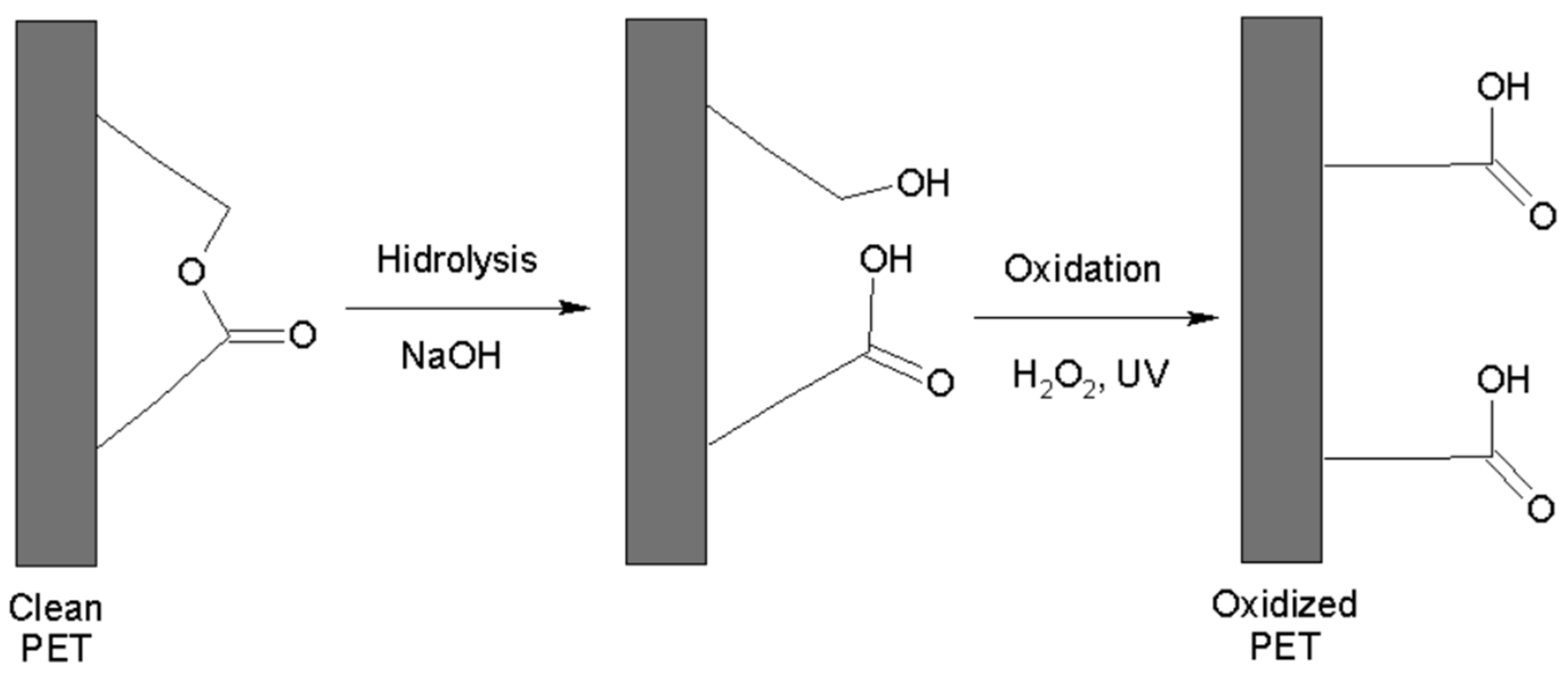

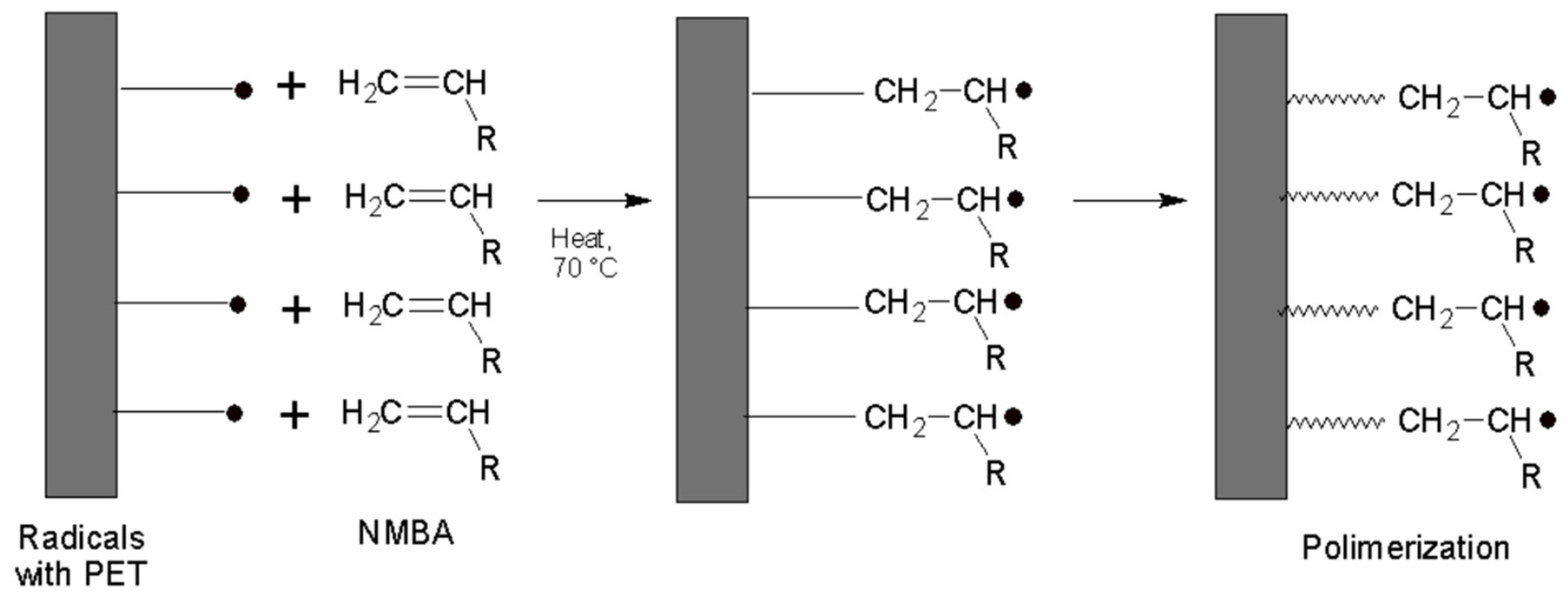


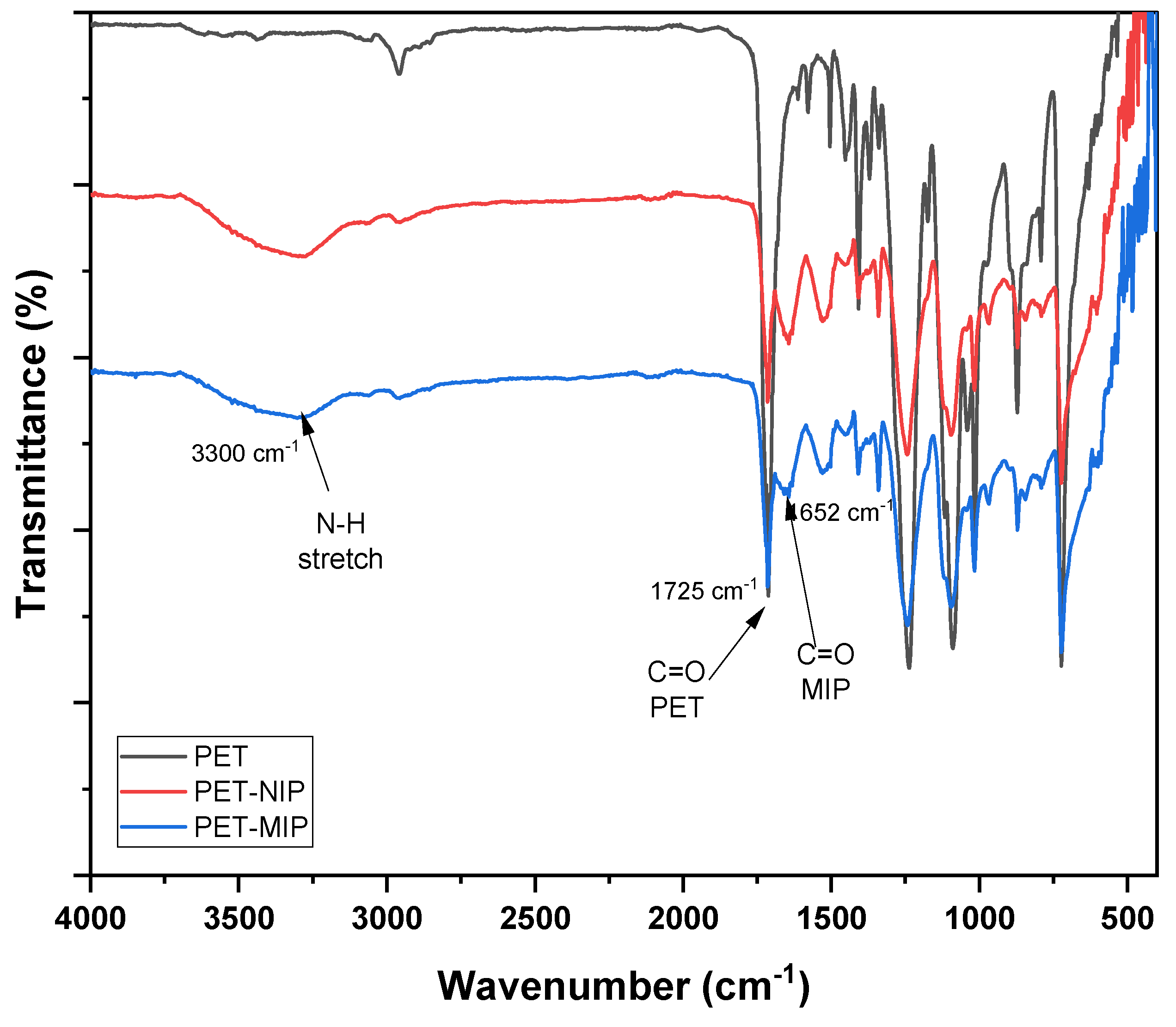


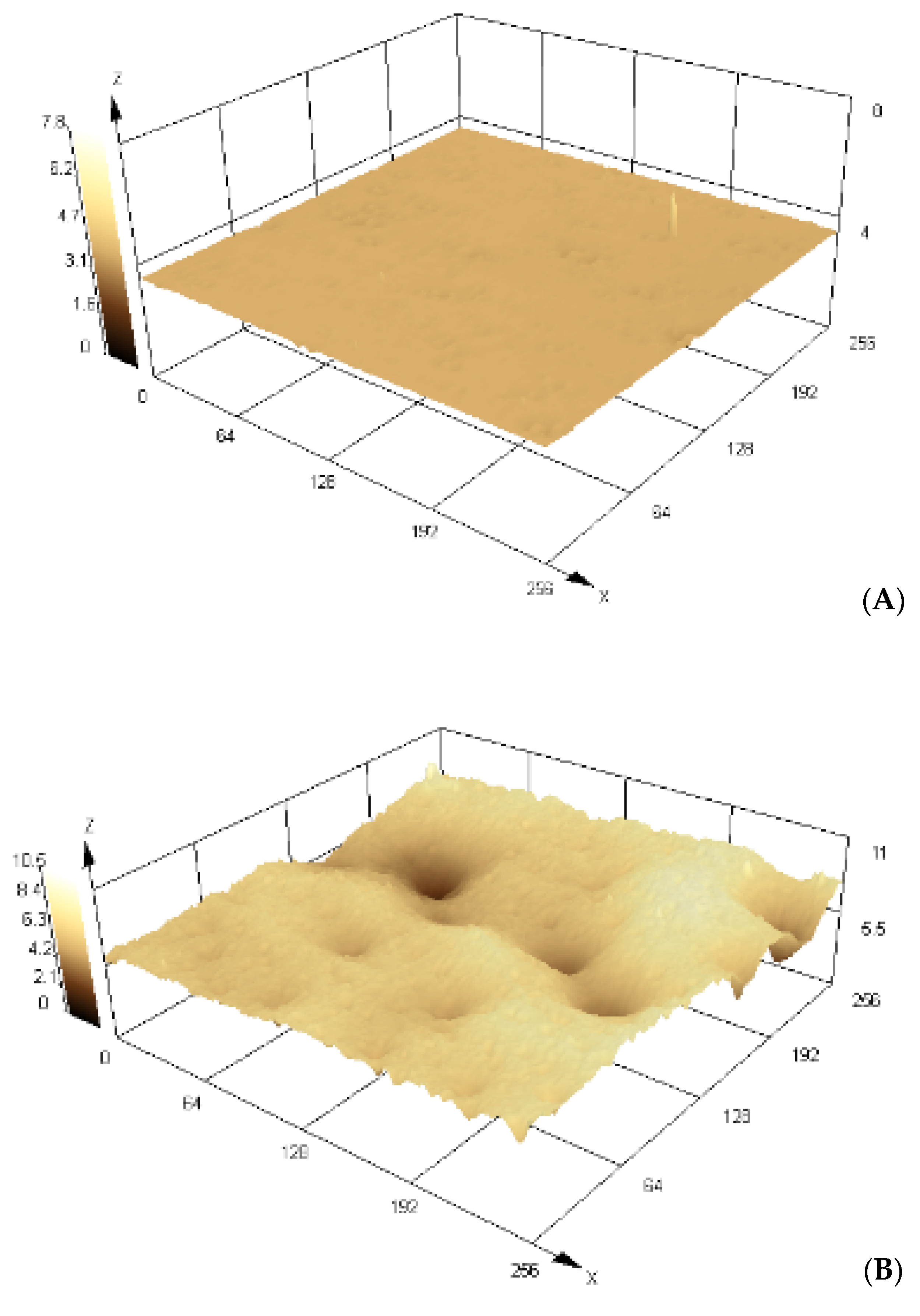


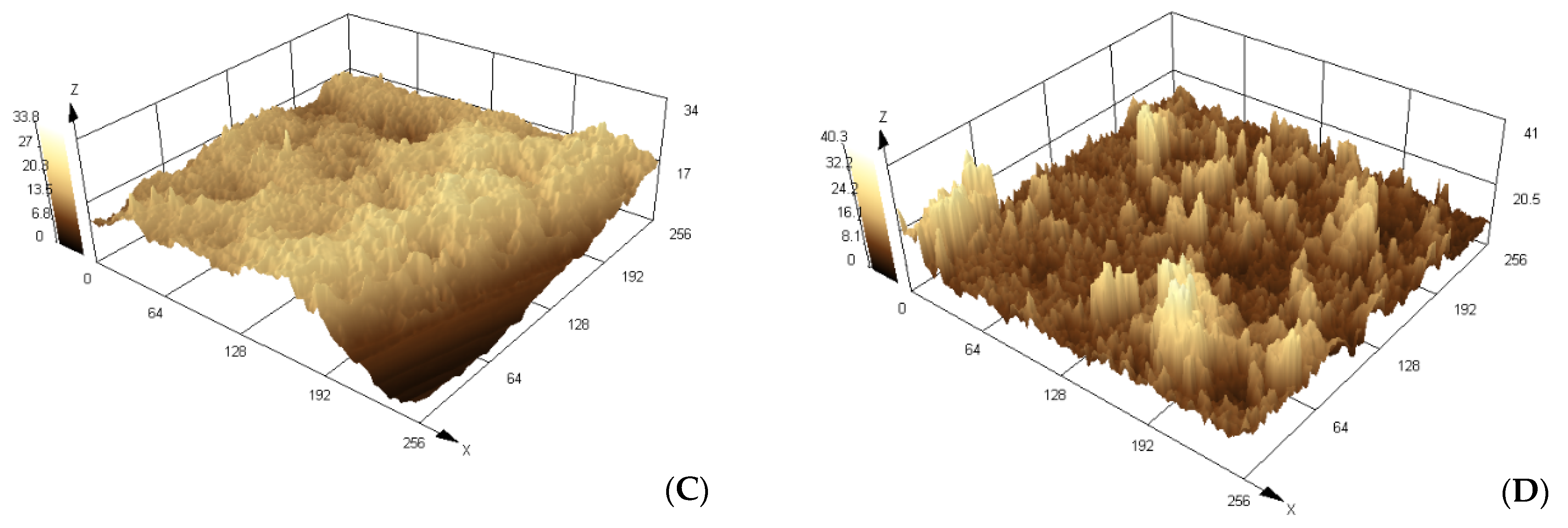
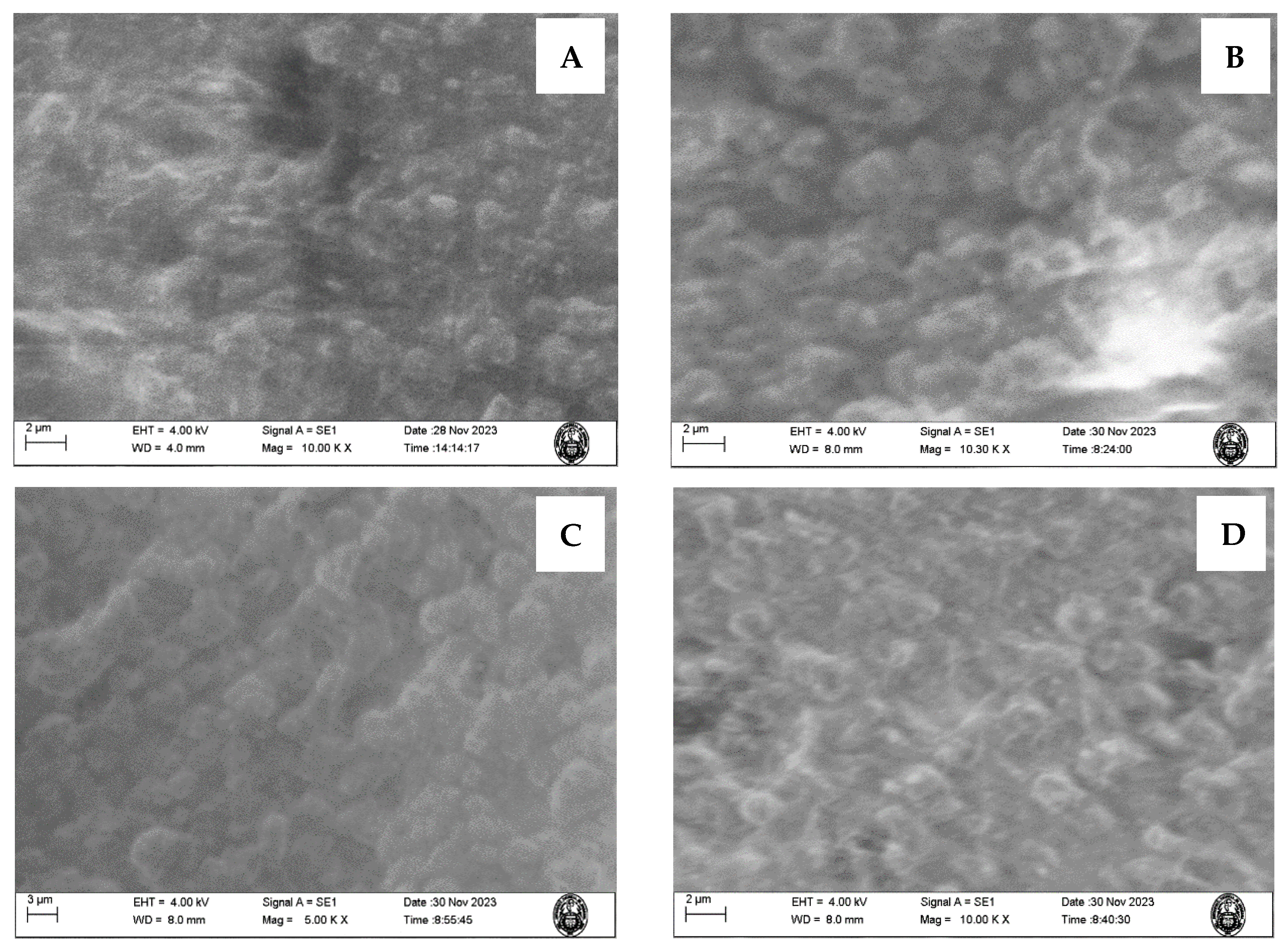
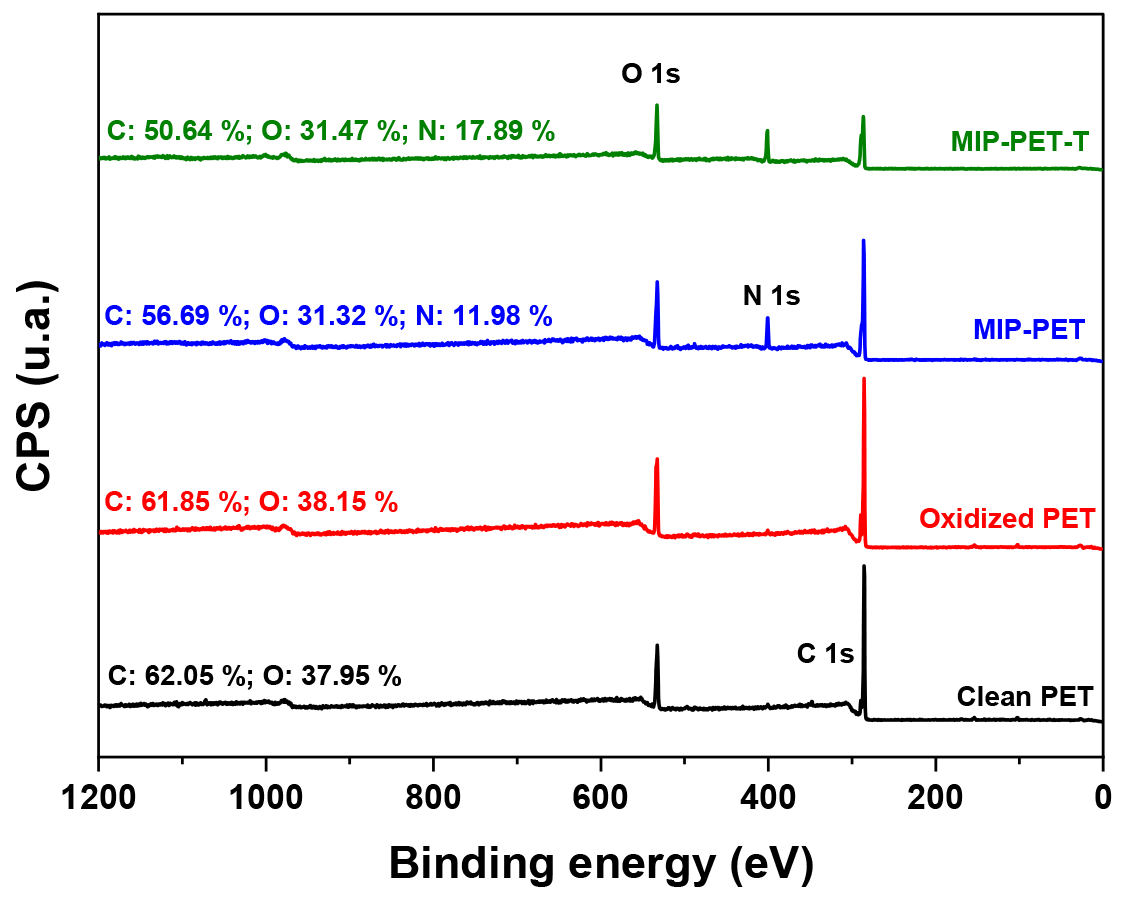
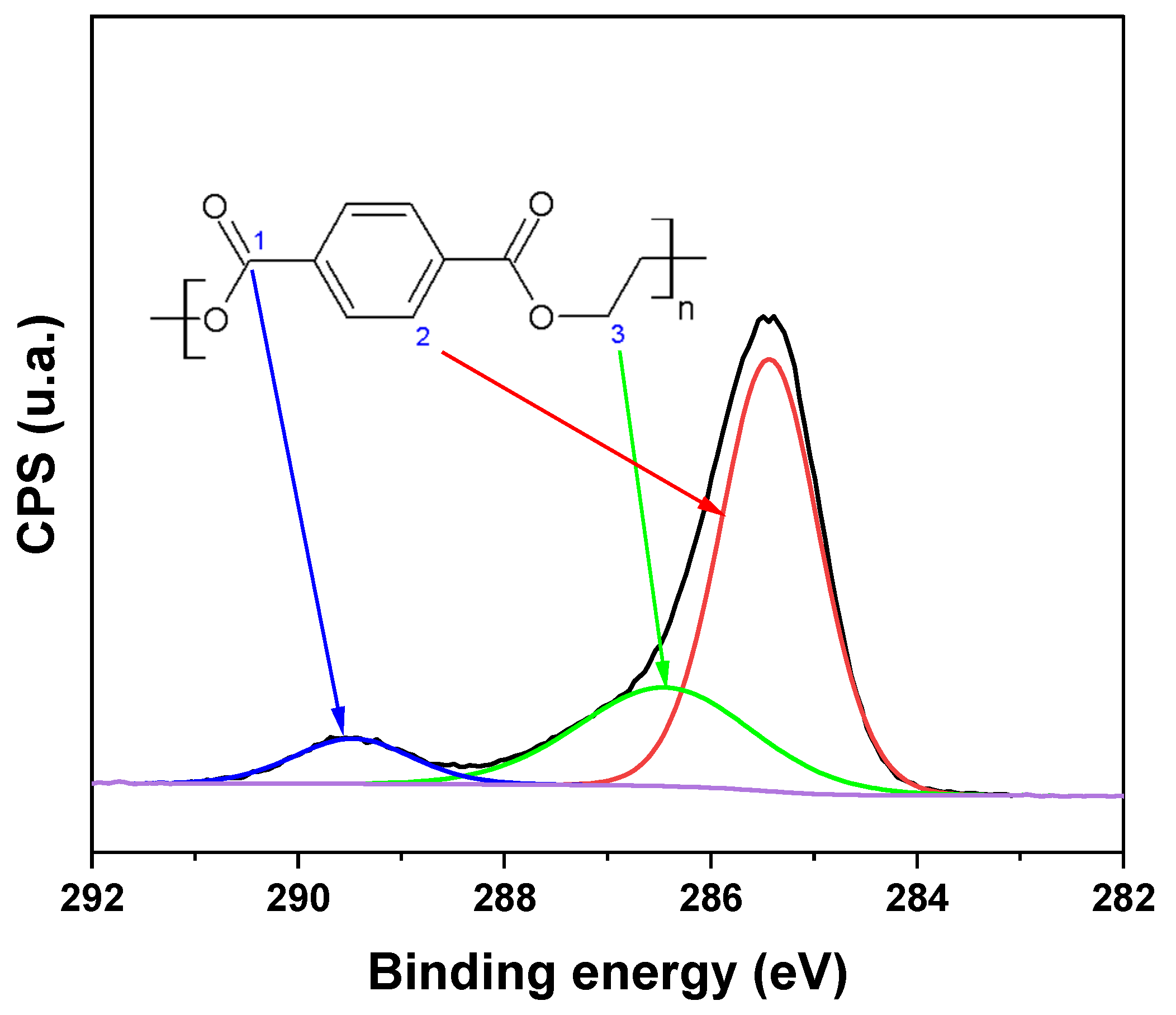
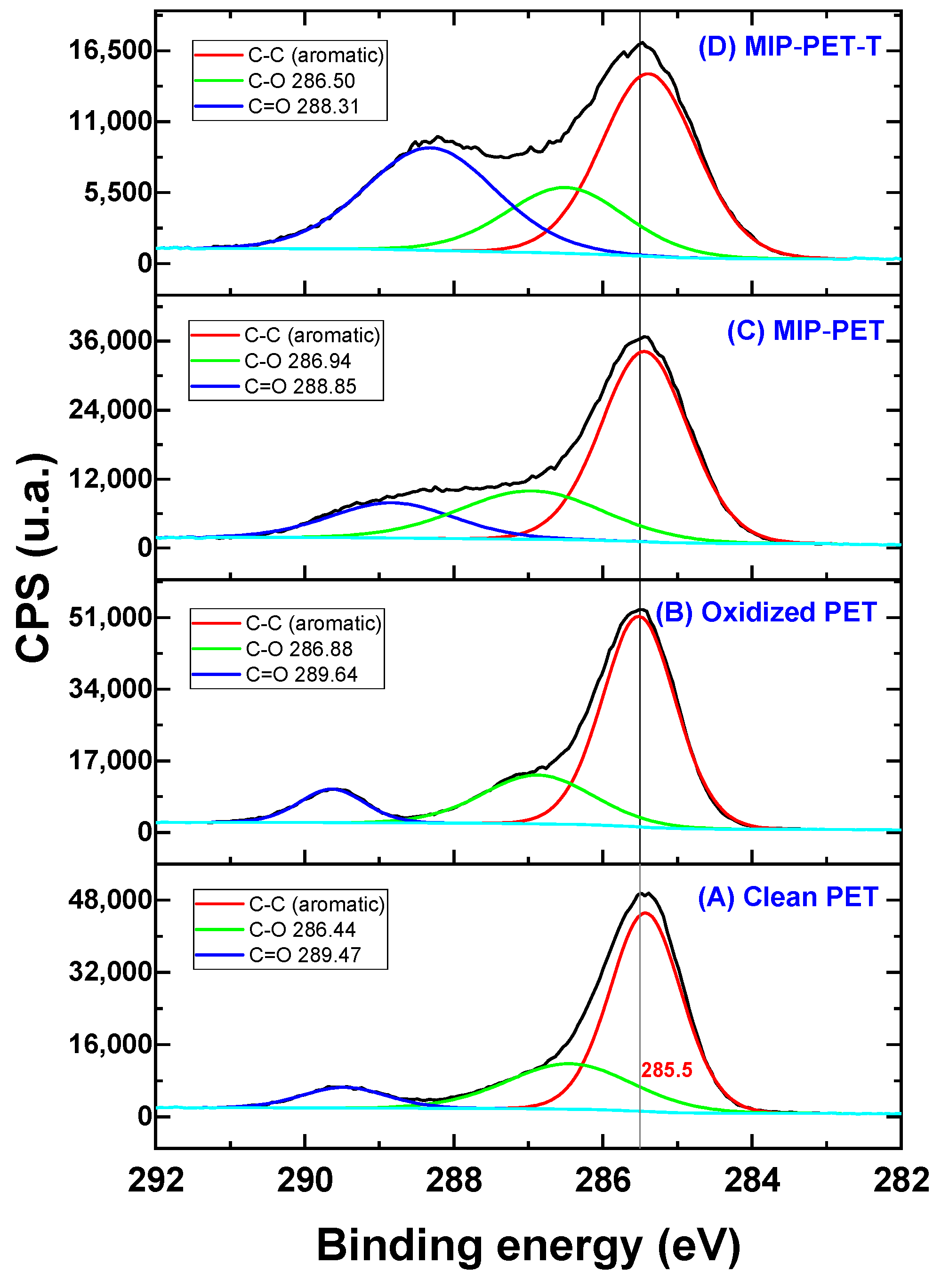
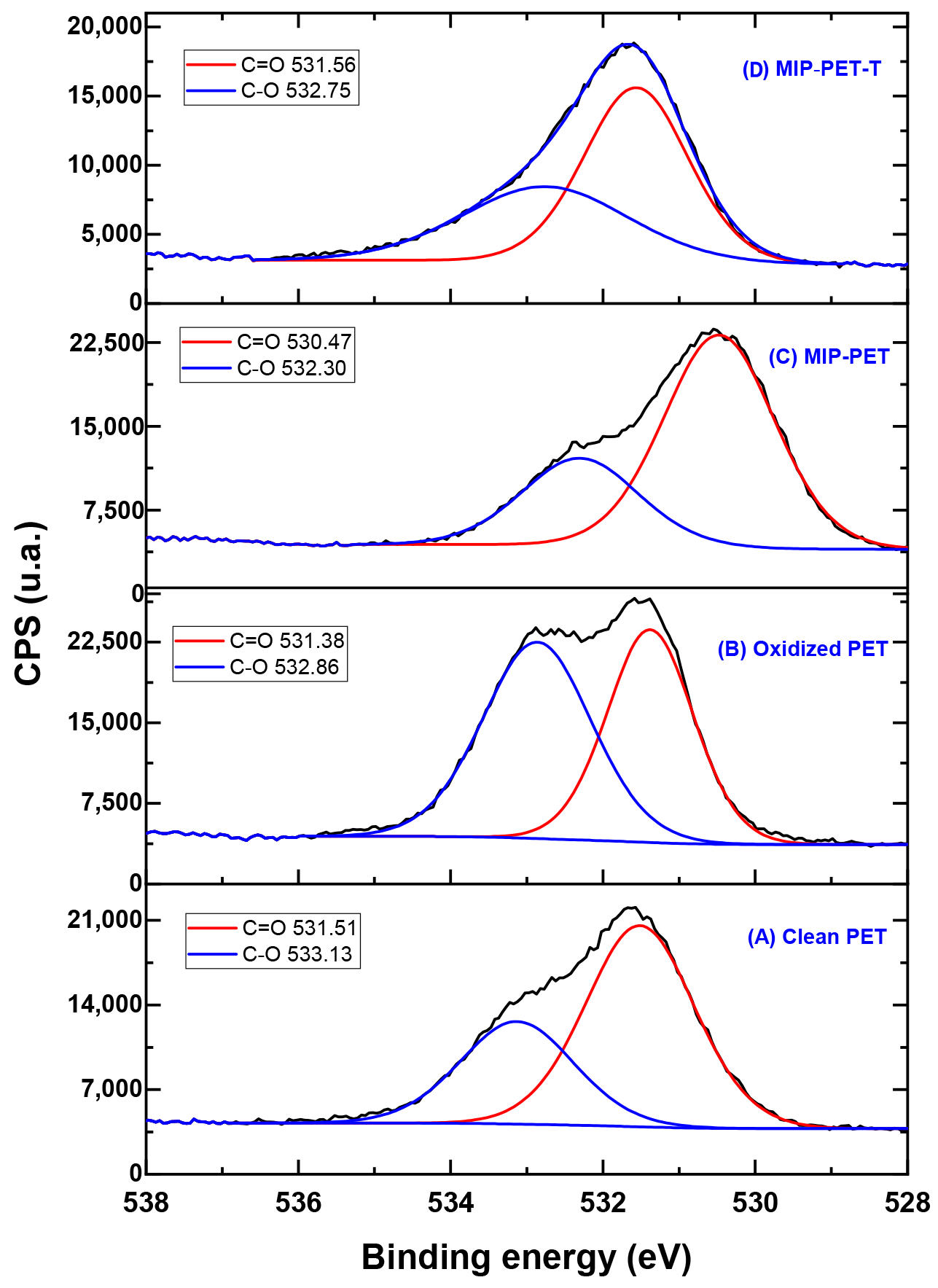
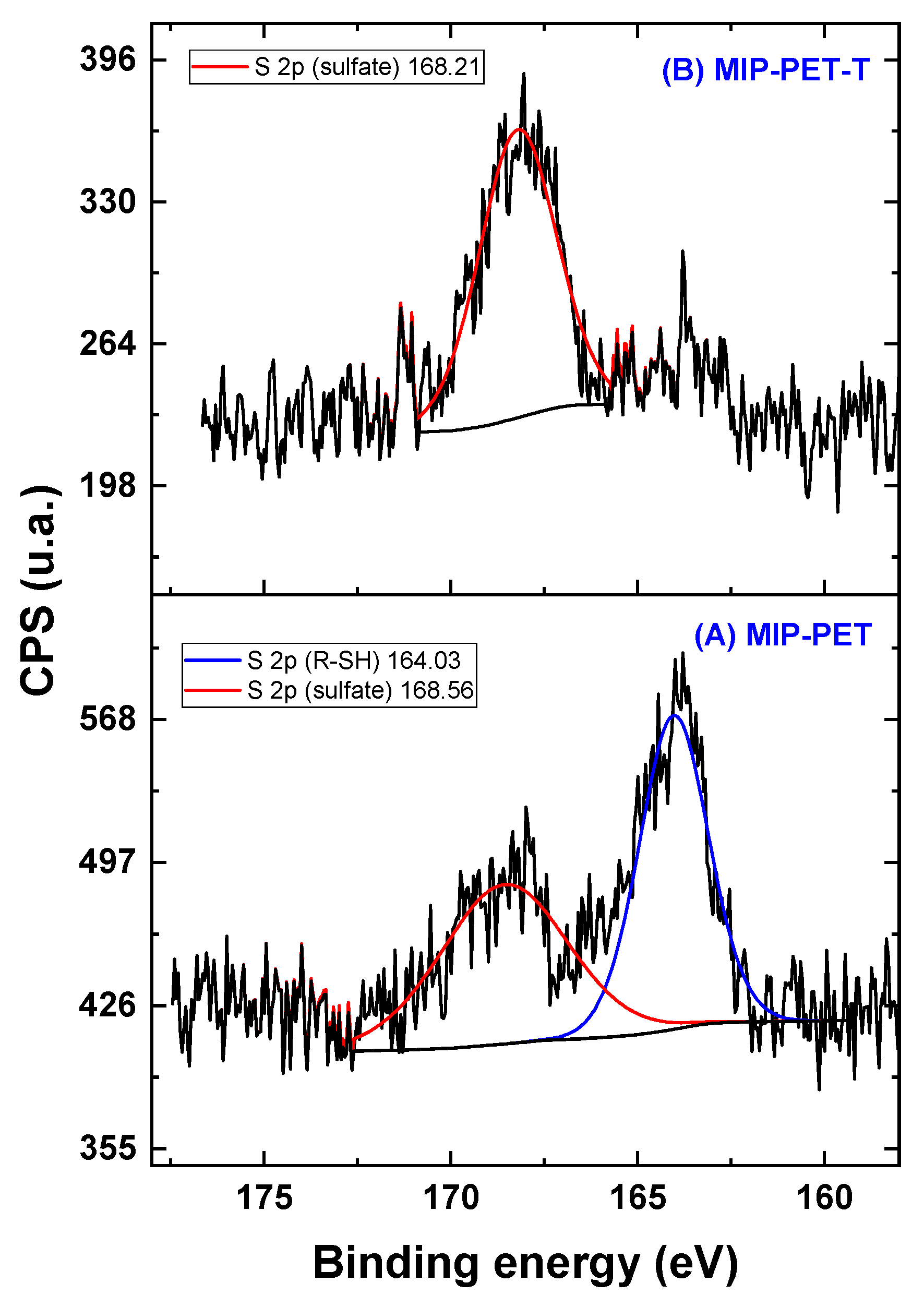

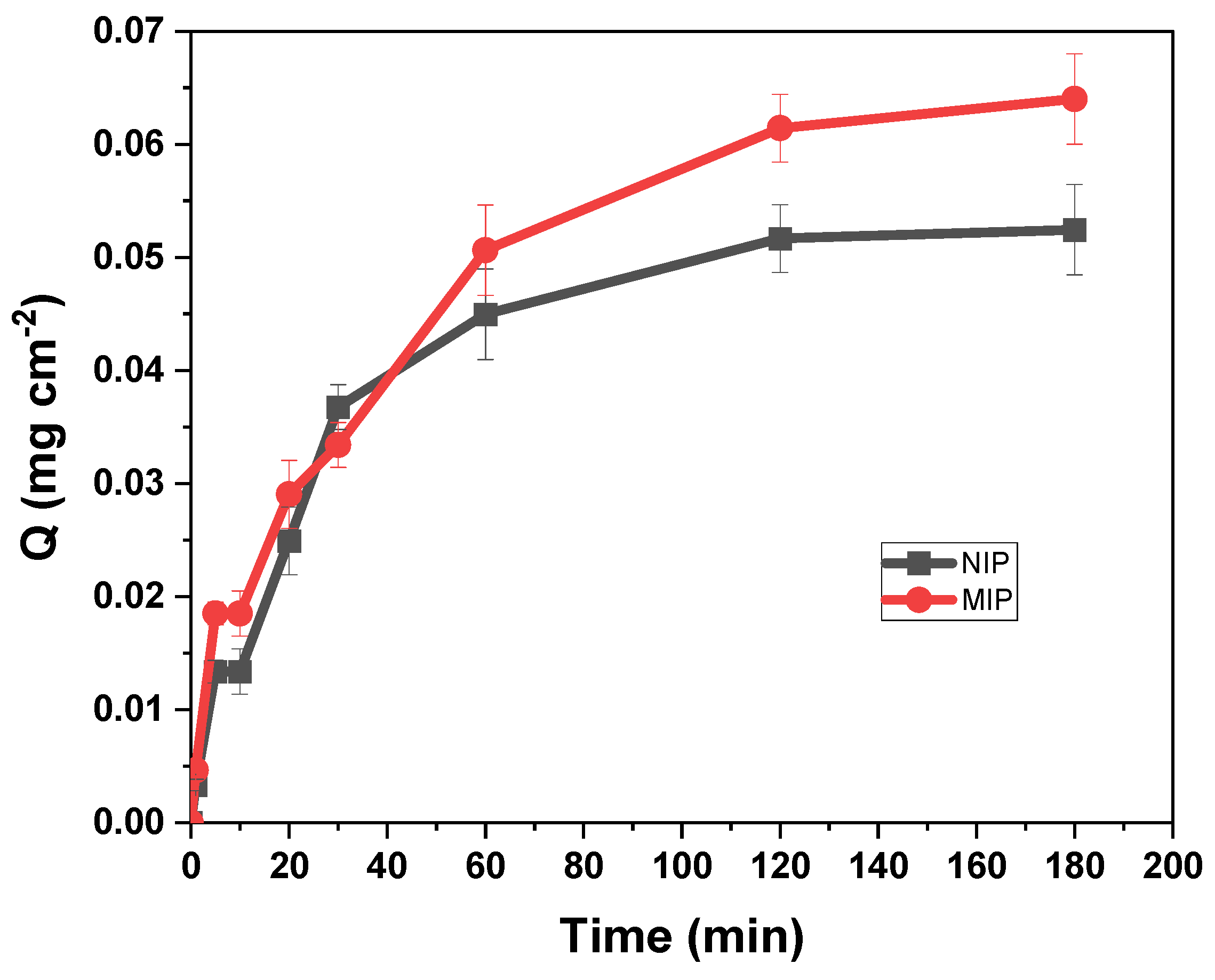

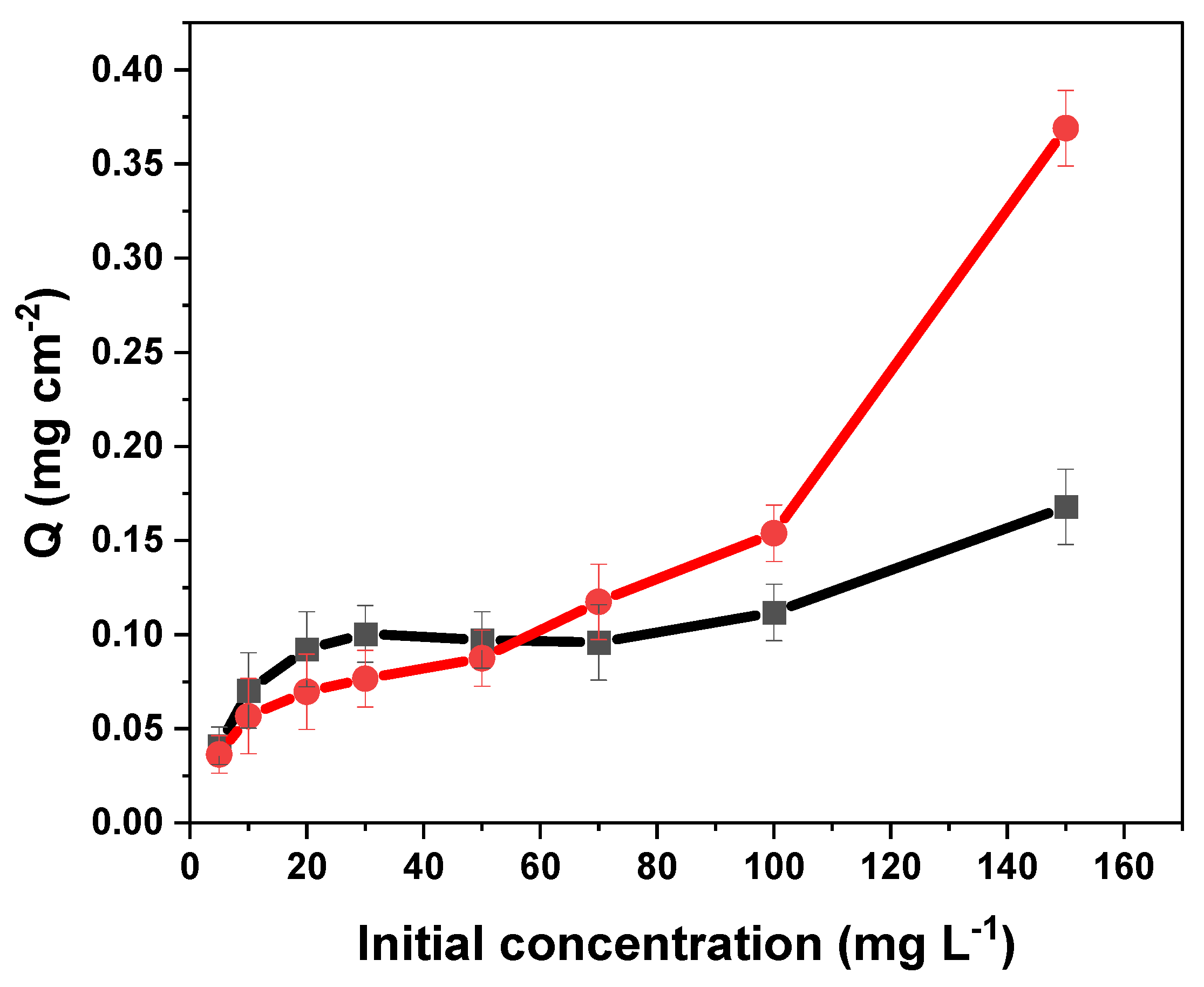
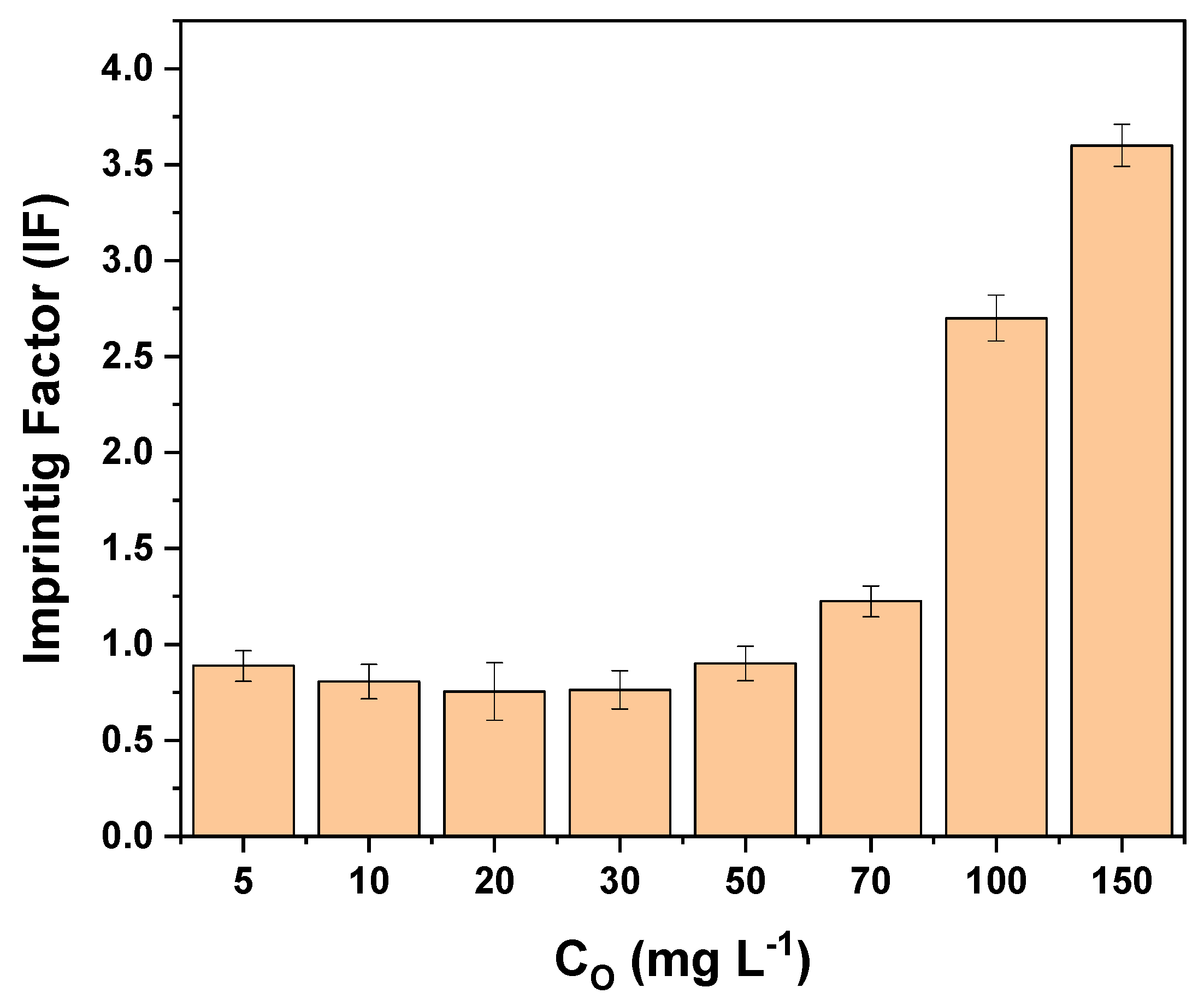

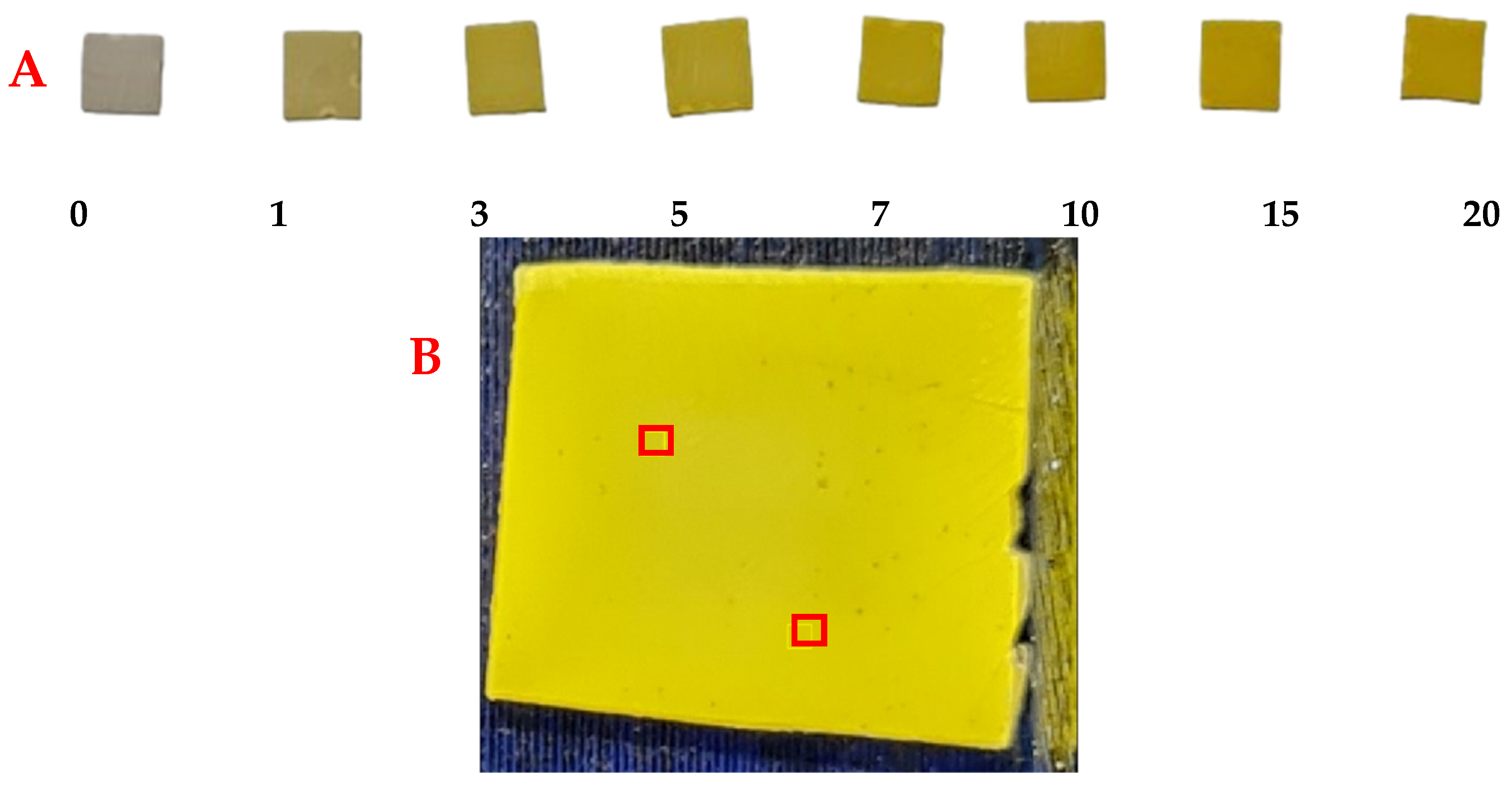



| MIP-PET | Ratio (MF + ME)/RAFT | Q (mg cm−2) |
|---|---|---|
| MIP1 | 1330 | 0.029 ± 0.002 |
| MIP2 | 560 | 0.025 ± 0.001 |
| MIP3 | 280 | 0.023 ± 0.003 |
| Kinetic Model | Parameters | |||
|---|---|---|---|---|
| Pseudo-first order | k1 = 0.023 | Qcal = 0.059 | Qexp = 0.064 | R2 = 0.9977 |
| Pseudo-second order | k2 = 0.013 | Qcal = 0.00373 | Qexp = 0.064 | R2 = 0.9759 |
| Intraparticle Diffusion | k1 = 5.046 | R2 = 0.9593 | ||
| Adsorption Model | Parameters | ||
|---|---|---|---|
| Langmuir | Qm = 0.1532 | b = 0.0785 | R2 = 0.9006 |
| Freundlich | n = 3.66 | Kf = 0.0375 | R2 = 0.9354 |
| Dye | Imprinting Factor (IF) | Selectivity Factor (β) |
|---|---|---|
| Basic red 46 | 0.88 | 3.08 |
| Methyl green | 0.80 | 3.39 |
| Sunset yellow | 1.20 | 2.26 |
| Yellow HE3G | 0.40 | 6.78 |
| Tartrazine | 2.70 | --- |
| Sample | Measured Value (mg L−1) |
|---|---|
| M1 | 4.14 |
| M2 | 4.51 |
| M3 | 6.56 |
| M4 | 4.44 |
| M5 | 5.62 |
| M6 | 5.01 |
| M7 | 4.15 |
| M8 | 5.36 |
| M9 | 5.02 |
| M10 | 4.89 |
| Average | 4.97 |
| Stand. Desv. | 0.74 |
| Sample | UV–Vis Method | Proposed Method (Smartphone) |
|---|---|---|
| M1 | 13.6 ± 0.1 (n = 3) | 14.1 ± 0.3 (n = 3) |
| M2 | 16.8 ± 0.2 (n = 3) | 16.5 ± 0.2 (n = 3) |
Disclaimer/Publisher’s Note: The statements, opinions and data contained in all publications are solely those of the individual author(s) and contributor(s) and not of MDPI and/or the editor(s). MDPI and/or the editor(s) disclaim responsibility for any injury to people or property resulting from any ideas, methods, instructions or products referred to in the content. |
© 2024 by the authors. Licensee MDPI, Basel, Switzerland. This article is an open access article distributed under the terms and conditions of the Creative Commons Attribution (CC BY) license (https://creativecommons.org/licenses/by/4.0/).
Share and Cite
Hernández, C.J.; Medina, R.; Maza Mejía, I.; Hurtado, M.; Khan, S.; Picasso, G.; López, R.; Sotomayor, M.D.P.T. Preparation of a Molecularly Imprinted Polymer on Polyethylene Terephthalate Platform Using Reversible Addition-Fragmentation Chain Transfer Polymerization for Tartrazine Analysis via Smartphone. Polymers 2024, 16, 1325. https://doi.org/10.3390/polym16101325
Hernández CJ, Medina R, Maza Mejía I, Hurtado M, Khan S, Picasso G, López R, Sotomayor MDPT. Preparation of a Molecularly Imprinted Polymer on Polyethylene Terephthalate Platform Using Reversible Addition-Fragmentation Chain Transfer Polymerization for Tartrazine Analysis via Smartphone. Polymers. 2024; 16(10):1325. https://doi.org/10.3390/polym16101325
Chicago/Turabian StyleHernández, Christian Jacinto, Raúl Medina, Ily Maza Mejía, Mario Hurtado, Sabir Khan, Gino Picasso, Rosario López, and María D. P. T. Sotomayor. 2024. "Preparation of a Molecularly Imprinted Polymer on Polyethylene Terephthalate Platform Using Reversible Addition-Fragmentation Chain Transfer Polymerization for Tartrazine Analysis via Smartphone" Polymers 16, no. 10: 1325. https://doi.org/10.3390/polym16101325
APA StyleHernández, C. J., Medina, R., Maza Mejía, I., Hurtado, M., Khan, S., Picasso, G., López, R., & Sotomayor, M. D. P. T. (2024). Preparation of a Molecularly Imprinted Polymer on Polyethylene Terephthalate Platform Using Reversible Addition-Fragmentation Chain Transfer Polymerization for Tartrazine Analysis via Smartphone. Polymers, 16(10), 1325. https://doi.org/10.3390/polym16101325








